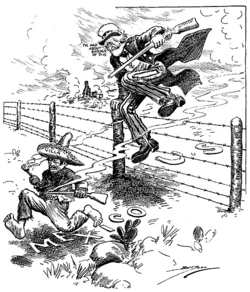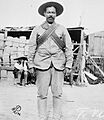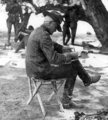Pancho Villa Expedition facts for kids
Quick facts for kids Pancho Villa Expedition |
|||||||
|---|---|---|---|---|---|---|---|
| Part of the Mexican Revolution, Border War | |||||||
 Cartoon by Clifford Berryman reflects American attitudes about the expedition |
|||||||
|
|||||||
| Belligerents | |||||||
|
|
|||||||
| Commanders and leaders | |||||||
|
|
|||||||
| Strength | |||||||
| c. 10,000 |
c. 500 (Conventionists) 22,000 (Constitutionalists) |
||||||
| Casualties and losses | |||||||
|
Conventionists:
Constitutionalists:
|
||||||
The Pancho Villa Expedition was a military operation by the United States Army. It took place from March 1916 to February 1917. The goal was to find and capture a Mexican revolutionary leader named Pancho Villa. This happened during the Mexican Revolution (1910–1920).
The U.S. Army went into Mexico because Villa's forces had attacked Columbus, New Mexico. President Woodrow Wilson wanted Villa captured. Even though U.S. troops found and defeated many of Villa's fighters, Villa himself managed to escape.
The search for Villa stopped when Mexican government troops, led by Venustiano Carranza, fought against the U.S. Army. This happened near the town of Parral. The U.S. mission then changed to avoiding more fights with Mexican troops. The expedition stayed in Mexico until February 1917. This was to encourage Carranza's government to keep looking for Villa. It also helped prevent more raids across the border.
Contents
Why the Expedition Happened
The Pancho Villa Expedition started because of an attack on an American town. On March 9, 1916, Pancho Villa and his soldiers attacked Columbus, New Mexico. They raided the town, causing damage and casualties. This made the U.S. government very angry.
President Woodrow Wilson decided to send the U.S. Army into Mexico. Their main goal was to capture Pancho Villa. This operation was led by General John J. Pershing.
What Happened During the Expedition
General Pershing led about 10,000 U.S. soldiers into Mexico. They used new technologies like trucks and airplanes. This was one of the first times these were used in a military operation. The soldiers searched for Villa across the desert.
They fought several battles against Villa's forces. U.S. troops were able to defeat many of Villa's fighters. However, Pancho Villa was very good at hiding. He knew the local area well, which made him hard to catch.
The expedition faced challenges beyond finding Villa. The Mexican government, led by President Venustiano Carranza, did not want U.S. troops in their country. They saw it as an invasion. This led to clashes between U.S. and Mexican government forces.
End of the Expedition
The active search for Villa lasted about a month. After that, the U.S. mission changed. The U.S. and Mexican governments tried to avoid a larger war. Diplomatic talks helped prevent more fighting.
The U.S. troops stayed in Mexico for almost a year. They hoped to pressure the Mexican government to deal with Villa. Finally, in February 1917, the U.S. forces left Mexico. Pancho Villa was never captured by the U.S. Army.
Impact and Legacy
Even though Villa was not captured, the expedition had important effects.
- It gave the U.S. Army valuable experience. Soldiers learned about training, supplies, and command in a foreign land. This experience was useful when the U.S. entered World War I later that year.
- General Pershing became a well-known figure. His leadership in Mexico helped him become the leader of American forces in France during World War I.
- The expedition also affected relations between the U.S. and Mexico. It led to more anti-American feelings in Mexico.
- Soldiers who took part in the expedition received the Mexican Service Medal.
Images for kids
See also
 In Spanish: Expedición punitiva contra Francisco Villa para niños
In Spanish: Expedición punitiva contra Francisco Villa para niños





